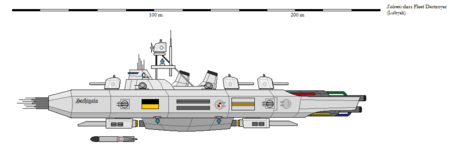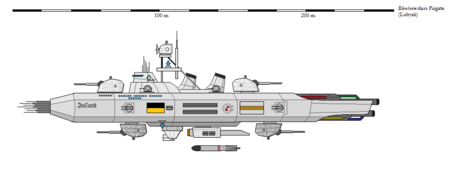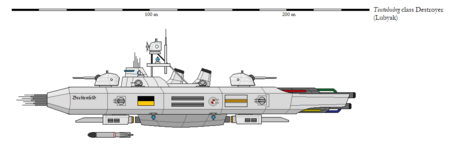Salamis-class Fleet Destroyer: Difference between revisions
m (1 revision imported) |
|
(No difference)
| |
Latest revision as of 23:10, 20 March 2019
The Salamis class Fleet Destroyer and the Blenheim class Frigate are exceptionally common vessels within the Imperial & Federal Navy, and used for a wide variety of purposes, including deep space control, escort, point defence, and light attack. In general, Salamis class vessels do not operate independently, but instead operate in flotillas and squadrons consisting of several small vessels, along with a larger vessel such as an Elbrus class light cruiser. Vessels of the Salamis and Blenheim class are named for famous military engagements and campaign in the history of the Imperial and Federal Union and Old Terra.
The Salamis class was developed to provide a cheap rapid response vessel which would complement the heavier, more expensive, slower, but more powerful vessels that made up the majority of the R.u.B fleet. The Salamis class was intended to provide a common hull from which various subclasses could be developed to suit various needs. The two most common varieties are the Salamis class fleet destroyer, intended to operate with the Scouting Fleet as a skirmishing vessel, and the Blenheim class frigate, which is a dedicated escort and point defence vessel. Other varieties of the class include the Ulm class communication frigate and the exceptionally rare Second Duskendale class stealth frigate.
Development
Operational Record
Characteristics
Power Generation & Propulsion
Weapons
Defences
Sensors & EW
Blenehim Class Frigate
The Blenheim class Frigate is a dedicated fleet and convoy escort vessel, based off of the same hullform and design of the Salamis class Fleet Destroyer. The Blenheim class sacrifices the heavy torpedo armament of the Salamis class, including the torpedo magazines and reloading mechanisms. Instead, the Blenheim class Frigate focuses on its anti-strike craft and point defence armament, retaining only a four tube single shot assembly of torpedoes as anti-capital armament.
The Blenehim class frigate mounts the highly effective Mark 10 Quick Firing Reinhold gun, firing a 22 kg bolt at a much higher velocity than the more common Mk IX dual-purpose gun. The high velocity and high fire rate of the Mark 10 makes it very effective weapon against small craft and munitions, while sacrificing some performance against heavily armoured targets. Even so, in combat actions, Mk 10 has proven effective against unshielded targets, by being able to destroy soft targets such as fire control systems and point defence batteries with explosive shells.
In addition to its main battery of Mk 10 QF guns, the Blenheim class also mounts sixteen FlaK-80 point-defence guns in eight twin mountings, as well as a standard eight tube point defence munitions launcher. These two systems complement the Mk 10 main battery by helping to both break up formations of strike craft or munitions at range, while providing a denser flak screen around the ship at closer ranges. When operating in full escort squadrons or flotillas, the combined formation can coordinate their anti-strike craft and point defence batteries into a dense flak screen, with an individual vessel able to concentrate its firepower on a single cone of threat.
The Blenheim class frigate is simultaneously intended to serve as an escort vessel, both for capital ships, and for convoys. To that extent, they are usually deployed in Escort Flotillas of three squadrons of four ships each, led by a Kilimanjaro class light cruiser. Escort Flotillas are usually assigned to provide close cover for convoys, protecting them against strike craft and other light raiders, or protecting capital ships of the battlewall against strike craft or long range munitions bombardment. Escort Flotillas are also commonly assigned to escort the Carrier Divisions of the Scouting Fleet, screening them against retaliatory attacks from hostile strike craft.
Teutoburg Class Destroyer
The Teutoburg class destroyer is a retrofit of the standard Salamis class Fleet Destroyer. The Teutoburg was developed in response to concerns that the R.u.B Navy lacked a true general purpose escort and picket ship, with existing frigates and destroyers being too focused on either anti-ship or anti-strike craft mission profiles. The Teutoburg was designed to fill this gap, maintaining the Salamis class's heavy torpedo armament, but replacing its gun battery with two twin Mk 10 QF guns, which provide improved anti-strike craft capability over the Mk IX gun.




